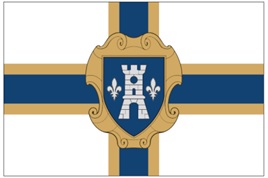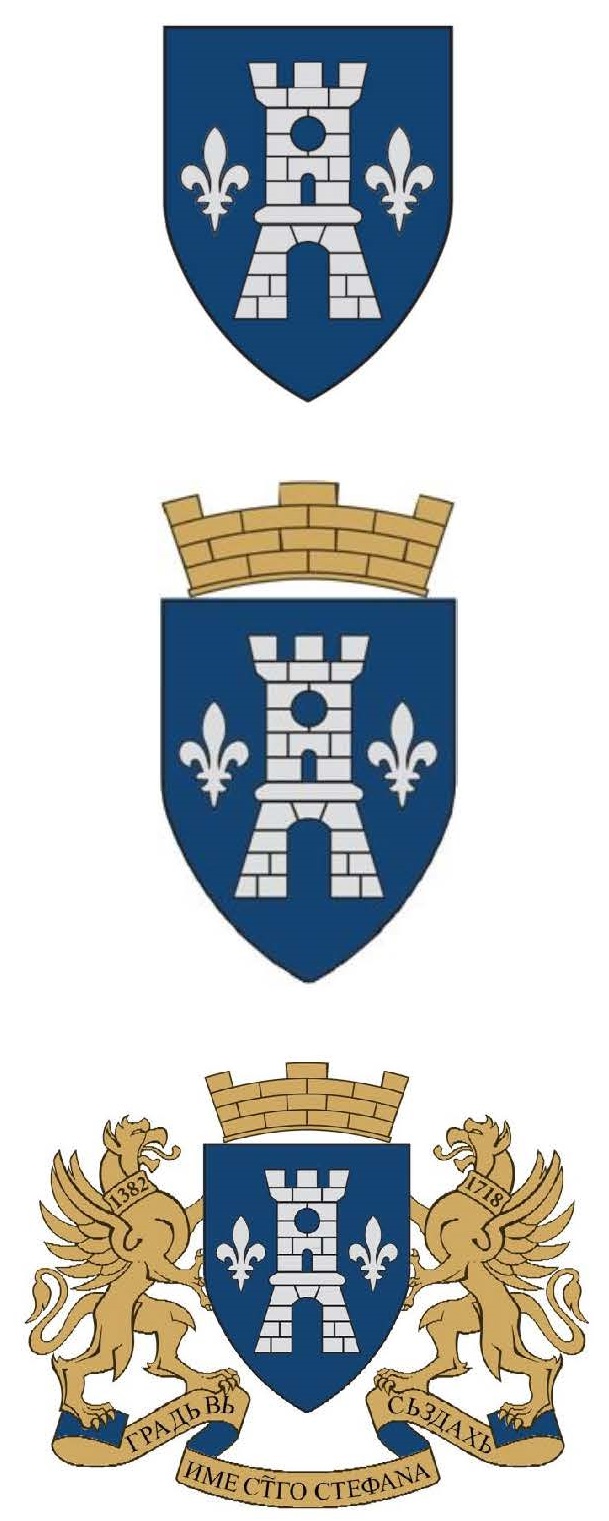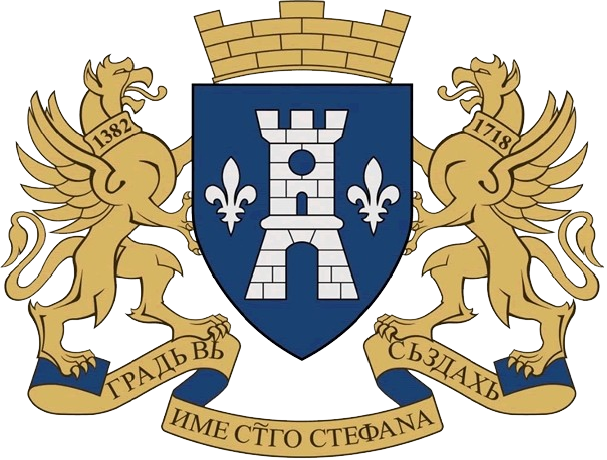The coat of arms of the Municipality consists of a blue heraldic triangular shield on which there is a silver stone-walled tower with a breastplate crown, an oculus and a door with an open field, placed between two silver lilies. Above the shield is a golden turret crown with three merlons. The shield is supported by two gold griffins in erect position with wings in swing and gold collars engraved with the years 1382 and 1718, resting on a gold band on a blue reverse.

The flag of the Municipality consists of a white field with a centrally placed vertical and horizontal beam, both blue, encrusted with gold, on the cross section of the beam is the small coat of arms of the municipality defined by a gold scroll - a medallion. The proportions of the sides of the flag are 2:3. The width of the beam is 5/31 of the height of the flag. The width of the circle is 2/31 of the height of the flag.

The coat of arms and flag of the Municipality of Herceg Novi tell a complex story about the history of the city and the heritage by which it is recognized, and were designed according to the strict rules of heraldry and vexillology.
The coat of arms is used according to the standards of municipal heraldry in three forms, as Small, Medium and Large, ceremonial coat of arms. The most complex representation is the Great Coat of Arms, while the Medium and Small Coat of Arms are created by reducing the elements of the Great Coat of Arms.

The great coat of arms consists of a heraldic shield in blue tincture, a series of towers and two lilies in silver enamel, a mural crown with three merlons in gold enamel, griffons guarding the shield in gold enamel, a gold enameled ribbon with an inscription and reverse in blue tincture.
The tower on the coat of arms of Herceg Novi represents symbolic continuity with the city seal adopted in 1883, which depicts the Torah (the main city gate in its then appearance), and which, with certain modifications during the 30s, 70s and 80s of the 20th century, survived as the bearer of the visual identity of Herceg Novi.
The rampart, i.e. the mural crown that adorns the coat of arms is the heraldic standard of the local self-government. It has three merlons that speak of the size of Heceg Novi, i.e. the number of inhabitants in relation to the total number of inhabitants in the country. The golden color of the mural crown indicates that Herceg Novi was founded by a king.
The lilies that surround the tower as a heraldic symbol have been associated with the city since the period of its creation in the 14th century, through the founder Kotromanić, but also the noble family Šimraković (later Stratinić-Stratimirović and Jovović), a local Old Slavic medieval nobility that inhabited part of today's western Montenegro. Branches of this family survived in the area of Herceg Novi during the Ottoman rule, and during the period of the Venetian administration, they contributed as holders of local administration and municipal donors, whose coat of arms can be found today on the main portal of the sacral complex of St. George and St. Spasa na Topla. In addition to these families, the famous Catholic families Burović-Zmajević and Buća also used the chrysin in their coats of arms in the area of Herceg Novi, who made an exceptional contribution to the development of the city as governors and chief commanders of the city's defense for decades during the administration of the Republic of Venice. The secondary meaning of the lily in heraldry is the wealth of vegetation, which is an important characteristic of Herceg Novi. If this symbol is interpreted in the context of Christian symbolism, the veil is a symbol of the Mother of God, and it is known that when all the Orthodox and Catholic churches in the Herceg Novi municipality are added together, the largest number are precisely those dedicated to the Mother of God.
The guardians of the shield are two golden griffins in an upright position, which together with the elements of the Small and Middle Coat of Arms make up the heraldic composition of the Great Coat of Arms. They were inspired by the oldest preserved depictions of heraldic figures of griffins found in the church of St. Stefan in Sušćepan, the value of which has been raised by the state of Montenegro to the level of cultural property of national importance. The griffins are found on the parapet slabs that come from the pre-Romanesque period, they are Byzantine works, dated to the 9th century, and testify to the life of Dračevica parish before the founding of modern Herceg Novi. In its original heraldic meaning, the griffin is a symbol of strength, leadership and courage.
The gryphons guarding the shield have necklaces engraved with the years of Herzegovinian honors - 1382 as the founding year of the city and 1718, the founding year of the Topal community, i.e. the acquisition of autonomy and the right to independent administration of the local population within the Republic of Venice. The city's founding year occupies the honorary heraldic right (visual left) side.
The support for the guardians of the shield is a ribbon on which there is an inscription "GRAДЬ ВЬ NMÊ STGO STEFANA SЬZDAЬ" (modern translation: City in the name of St. Stephen sazdah). The inscription is given authentically, in the original Old Slavonic script, and is an abridged extract from the "Charter of King Tvrtko I" from 1382, which mentions the date of the city's foundation.
The colors on the symbols of Herceg Novi reflect the key characteristics and values of the municipality: blue represents the sea and sky, silver (white) – purity, wisdom and peace, and gold – wealth, value and tradition.
The author of the city's symbols is Srđan Marlović, an architect and heraldist from Novlja.





